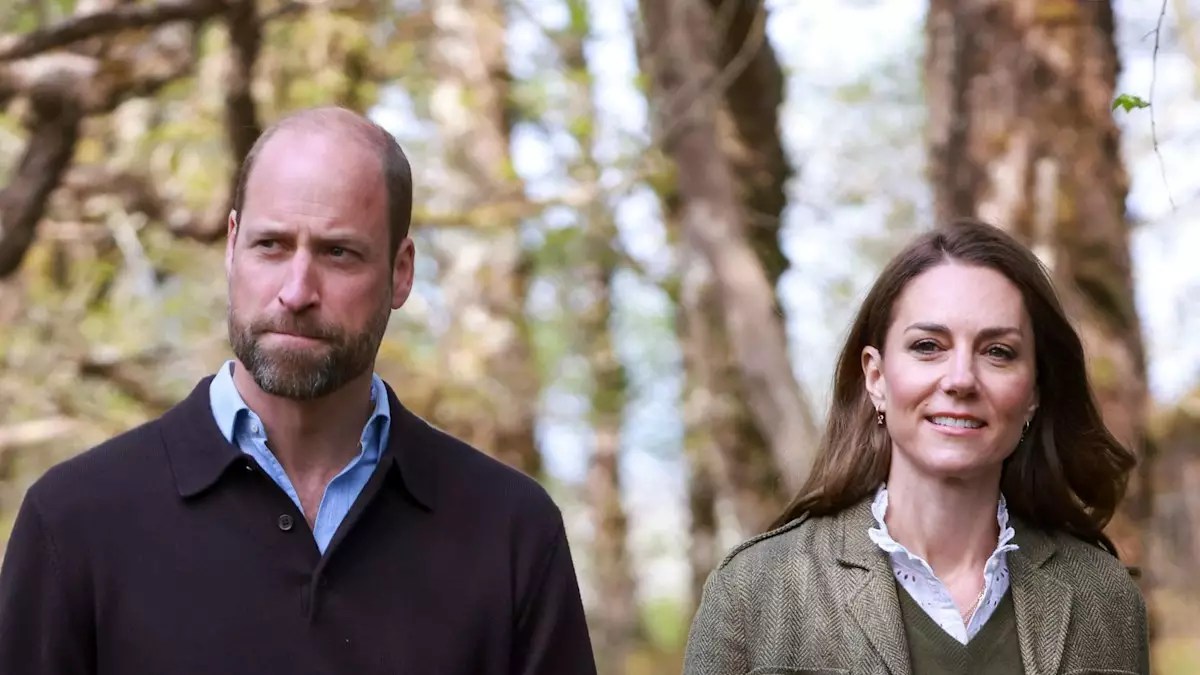When royalty steps beyond ceremonial duties and into the realm of environmental action, the impact resonates far beyond photo opportunities. The Prince and Princess of Wales recently demonstrated this through their meaningful expedition across the Scottish Isles, transforming what might have appeared as a simple anniversary celebration into something far more significant – a powerful testament to community engagement, environmental conservation, and authentic human connection.
Beyond the Crown: A Royal Mission with Purpose
The royal couple’s exploration of the Ardura Community Forest wasn’t orchestrated merely for publicity. Their visit represented something much more substantial – a deliberate choice to spotlight the vital importance of preserving natural landscapes for future generations. By spending time with the Countryside Rangers from the Mull and Iona Ranger Service, William and Kate showed a level of engagement that transcends traditional royal appearances.
What’s particularly noteworthy is The Royal Foundation’s concrete pledge of support for the Mull and Iona Ranger Service. This commitment demonstrates how the couple is leveraging their influence to address genuine environmental challenges. It’s honestly refreshing to see public figures of their stature moving beyond symbolic gestures toward actions that could create lasting positive change.
“Conservation efforts require sustained support, not just attention,” explained one of the rangers during the visit. “Having the recognition from the royal family brings visibility to work that often happens quietly in these remote communities.”
Authentic Community Engagement: Listening Before Leading
Their approach to community interaction deserves special attention. Rather than arriving with predetermined messages, the royal couple traveled by ferry to the Isle of Iona and did something surprisingly simple yet powerful – they listened. Local islanders shared their experiences, challenges, and hopes, creating a genuine exchange that bridged the divide between royal life and everyday reality.
This listening-first approach represents a fundamental shift in how influential figures can approach complex issues like environmental conservation. By acknowledging local wisdom and lived experience, William and Kate modeled how conservation succeeds when it’s collaborative rather than dictated from above.
Getting Their Hands Dirty: Participation Over Performance
At the Aros Hall community hub, the Prince and Princess didn’t maintain a safe distance as observers. Instead, they actively participated – painting walls and contributing to a community mural alongside local residents. Their willingness to roll up their sleeves (quite literally) offered a glimpse of authenticity that resonated with everyone present.
In a light-hearted moment that captured their approachable nature, William jokingly referenced finding “Banksy” during their painting session, bringing laughter to what could have been an overly formal occasion. These human touches transform traditional royal visits into meaningful connections.
One community member remarked, “Seeing them pick up paintbrushes and work alongside us – that sends a message about the kind of leadership they represent. It’s about doing the work, not just talking about it.”
From Farm to Table: Celebrating Local Food Systems
Perhaps one of the most compelling aspects of their journey was their visit to Croft 3, where William and Kate joined local farmers and schoolchildren in a cooking session that highlighted the critical intersection of community, agriculture, and sustainability.
The preparation of haggis wrapped in chard wasn’t merely a culinary activity – it served as a powerful demonstration of how local food systems support community resilience, cultural heritage, and environmental health. By participating in this cooking experience, the royal couple acknowledged the fundamental connection between how we produce food and our relationship with the land.
The Ripple Effect of Local Food Choices
- Reduced carbon footprint through minimal transportation
- Support for traditional farming practices that maintain biodiversity
- Strengthened local economies through direct producer-consumer relationships
- Preservation of cultural food traditions that might otherwise be lost
A local farmer who participated in the cooking session shared, “Having the Prince and Princess take interest in our traditional methods validates what many of us have been doing for generations. It helps the younger generation see value in these practices.”
Education Through Immersion: Learning in Natural Settings
The royal couple’s interaction with student rangers highlighted their commitment to environmental education. Rather than making formal speeches about the importance of conservation, they engaged directly with young people learning practical conservation skills in the field.
This approach recognizes that meaningful environmental education happens through hands-on experience, not just classroom learning. By showing interest in how these young rangers were developing their skills, William and Kate underscored the importance of practical knowledge in addressing environmental challenges.
“We’re seeing a disconnect between young people and nature,” commented an educator present during the visit. “Having such prominent figures show genuine interest in outdoor learning sends a powerful message about reconnecting with our natural world.”
Building Skills for Future Conservation
The student rangers demonstrated various conservation techniques during the royal visit, from habitat assessment to species identification. This exchange highlighted how traditional ecological knowledge can complement modern conservation science – a balance that’s increasingly recognized as essential for effective environmental stewardship.
The Prince, drawing on his own environmental initiatives, engaged the students in thoughtful discussion about career pathways in conservation, legitimizing these career choices at a time when many young people are seeking meaningful work that addresses global challenges.
A New Model of Royal Engagement
This Scottish Isles expedition represents a significant evolution in how the royal family approaches public engagement. By prioritizing genuine connection, environmental consciousness, and community empowerment, William and Kate are crafting a contemporary approach to their roles that resonates with current social values and concerns.
Their approach stands in contrast to more traditional ceremonial appearances, offering instead a model of engagement that emphasizes listening, learning, and participating. This shift represents an understanding that modern leadership – royal or otherwise – requires authenticity and responsiveness to pressing global challenges.
Core Elements of Their Approach
- Genuine participation rather than ceremonial presence
- Amplifying local voices instead of speaking over them
- Supporting existing community initiatives rather than imposing external solutions
- Connecting environmental concerns with community wellbeing
- Demonstrating the value of traditional knowledge alongside modern approaches
Creating Lasting Impact Beyond the Visit
What distinguishes this royal journey from typical official visits is the attention to creating sustainable impact. The Royal Foundation’s support for the ranger service ensures that the benefits extend far beyond the days the couple spent in the Scottish Isles.
This focus on lasting change rather than momentary publicity demonstrates a mature understanding of how influence can be leveraged for meaningful outcomes. By establishing partnerships with local organizations already doing important work, the royal couple maximizes the potential for genuine, long-term impact.
A community leader reflected, “Many high-profile visits come and go with little lasting effect. What feels different here is the commitment to supporting what’s already working, rather than starting something new that might not last.”
Lessons for Environmental Leadership
The approach demonstrated by the Prince and Princess offers valuable insights for anyone in a position of influence regarding environmental issues:
Key Takeaways for Effective Conservation Leadership
- Environmental stewardship thrives when it’s inclusive and community-centered
- Listening to local knowledge enhances conservation outcomes
- Participation creates deeper understanding than observation alone
- Supporting existing initiatives often yields greater results than creating new programs
- Connecting cultural traditions with conservation creates stronger buy-in
Their journey through the Scottish Isles illustrates how conservation becomes most effective when approached as a shared responsibility rather than an imposed directive. By bridging traditional royal influence with grassroots environmental action, William and Kate have demonstrated a model that combines the best of both worlds.
Moving Forward: The Path Ahead
As climate challenges intensify and communities worldwide grapple with environmental changes, the approach modeled during this royal visit offers a template worth considering. Conservation succeeds when it honors local knowledge, supports existing efforts, and creates meaningful connections between people and place.
The message emerging from this journey is clear and compelling: effective conservation isn’t an abstract concept or distant ideal. It’s a living practice that demands commitment, empathy, and concrete action from everyone, regardless of their position or title. And sometimes, the most meaningful contribution begins with something as simple as showing up, rolling up your sleeves, and genuinely engaging with the community working to protect what matters.
In an age where environmental challenges can feel overwhelming, this royal expedition reminds us that meaningful progress often starts with authentic human connection and a willingness to listen, learn, and act together. That may be the most valuable lesson of all from this remarkable journey through the Scottish Isles.


Leave a Reply